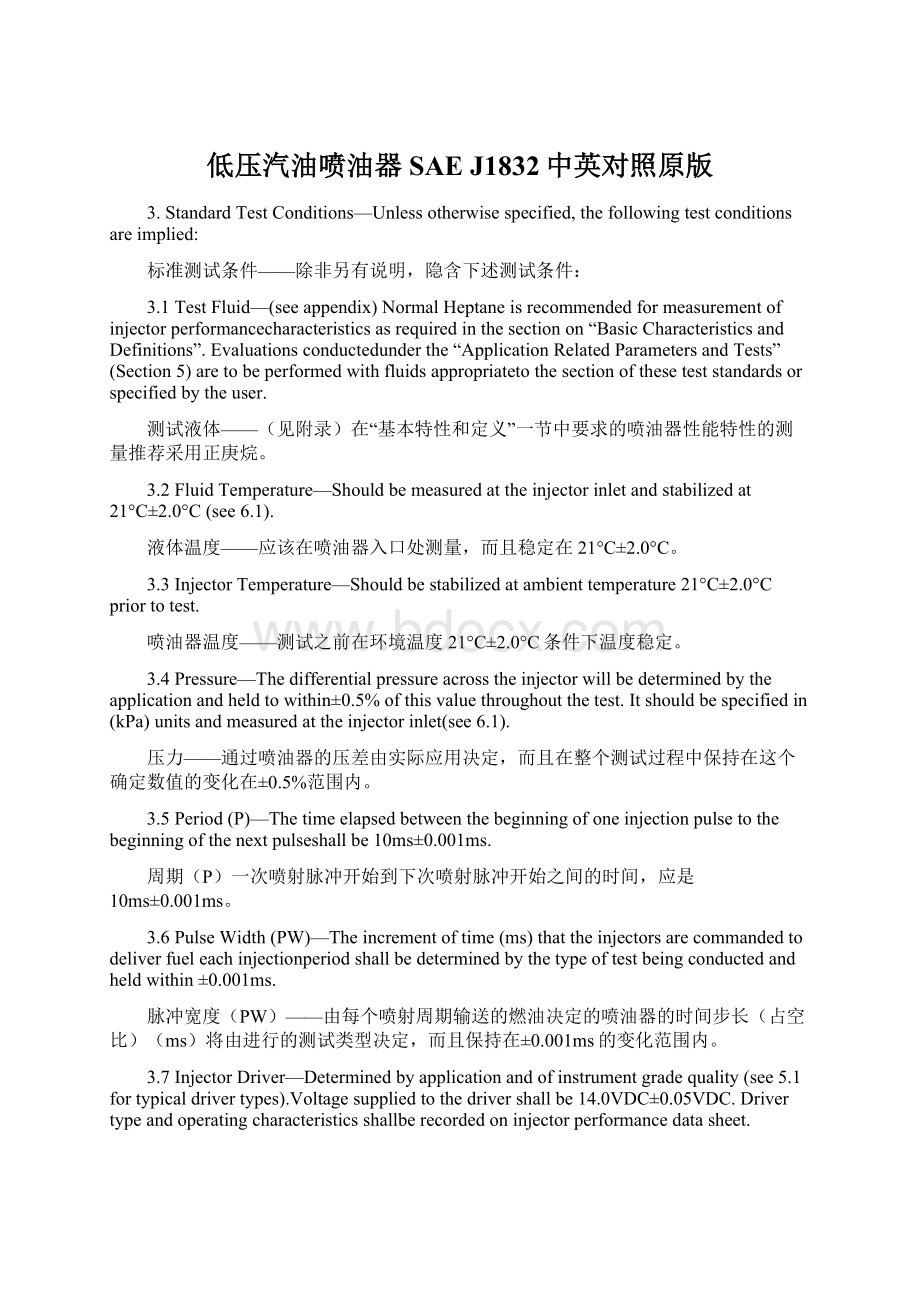低压汽油喷油器SAE J1832中英对照原版.docx
《低压汽油喷油器SAE J1832中英对照原版.docx》由会员分享,可在线阅读,更多相关《低压汽油喷油器SAE J1832中英对照原版.docx(43页珍藏版)》请在冰豆网上搜索。

低压汽油喷油器SAEJ1832中英对照原版
3.StandardTestConditions—Unlessotherwisespecified,thefollowingtestconditionsareimplied:
标准测试条件——除非另有说明,隐含下述测试条件:
3.1TestFluid—(seeappendix)NormalHeptaneisrecommendedformeasurementofinjectorperformancecharacteristicsasrequiredinthesectionon“BasicCharacteristicsandDefinitions”.Evaluationsconductedunderthe“ApplicationRelatedParametersandTests”(Section5)aretobeperformedwithfluidsappropriatetothesectionoftheseteststandardsorspecifiedbytheuser.
测试液体——(见附录)在“基本特性和定义”一节中要求的喷油器性能特性的测量推荐采用正庚烷。
3.2FluidTemperature—Shouldbemeasuredattheinjectorinletandstabilizedat21°C±2.0°C(see6.1).
液体温度——应该在喷油器入口处测量,而且稳定在21°C±2.0°C。
3.3InjectorTemperature—Shouldbestabilizedatambienttemperature21°C±2.0°Cpriortotest.
喷油器温度——测试之前在环境温度21°C±2.0°C条件下温度稳定。
3.4Pressure—Thedifferentialpressureacrosstheinjectorwillbedeterminedbytheapplicationandheldtowithin±0.5%ofthisvaluethroughoutthetest.Itshouldbespecifiedin(kPa)unitsandmeasuredattheinjectorinlet(see6.1).
压力——通过喷油器的压差由实际应用决定,而且在整个测试过程中保持在这个确定数值的变化在±0.5%范围内。
3.5Period(P)—Thetimeelapsedbetweenthebeginningofoneinjectionpulsetothebeginningofthenextpulseshallbe10ms±0.001ms.
周期(P)一次喷射脉冲开始到下次喷射脉冲开始之间的时间,应是10ms±0.001ms。
3.6PulseWidth(PW)—Theincrementoftime(ms)thattheinjectorsarecommandedtodeliverfueleachinjectionperiodshallbedeterminedbythetypeoftestbeingconductedandheldwithin±0.001ms.
脉冲宽度(PW)——由每个喷射周期输送的燃油决定的喷油器的时间步长(占空比)(ms)将由进行的测试类型决定,而且保持在±0.001ms的变化范围内。
3.7InjectorDriver—Determinedbyapplicationandofinstrumentgradequality(see5.1fortypicaldrivertypes).Voltagesuppliedtothedrivershallbe14.0VDC±0.05VDC.Drivertypeandoperatingcharacteristicsshallberecordedoninjectorperformancedatasheet.
喷油器驱动——由实际应用和仪器质量等级决定(见5.1的典型驱动类型)。
驱动电压应是14.0VDC±0.05VDC。
在喷油器性能数据表中记录驱动类型和操作特性。
3.8Polarity—Maintainedconstantthroughoutalltestingandsameasthatusedintheapplication.
极性——在整个测试过程中保持不变,而且与实际应用中使用相同。
3.9TestApparatus—Thetypeofflowfixtureusedwillvarydependingontheparticularinjectorparameterbeingevaluated(Section6).
测试装置——流体夹具类型根据特定的喷油器的被评价参数而变化。
3.9.1INSTRUMENTS—Stabilizedpermanufacturers’recommendations.
仪器——根据每个制造商的建议,仪器稳定
3.9.2INJECTORPOSITION—Theinjectorshouldbemountedverticallyunlessotherwisedesignatedintherelativetestprocedure.
喷油器位置——喷油器应该垂直安装,除非在相关的测试过程中另外标明。
3.9.3PRECONDITIONING—Purgeinjectorsandtestapparatuswithtestfluidtoremoveallair,vapors,andshippingfluids.Flowinjectorsfor10000pulsesat5msPWand10msP.Discardpurgefluid.
预处理——用测试液清洗喷油器,去除所有的空气、蒸气和运输时的液体。
循环清洗喷油器10000个喷油脉冲,脉冲周期为10ms脉宽为5ms。
3.9.4FLOWMEASUREMENT—Flowratemaybemeasuredbyeithervolumeormassflowwiththelatterbeingthepreferredmethod.Datashouldbereportedinmassflowunits(g/sormg/pulse)andallpertinentinformationshallberecorded(numberofpulses,fuelmass,etc.).Priortoflowmeasurement,theinjectorshouldbewarmedupforaminimumof5000pulsesat5msPWand10msP.Dynamicflowmeasurementshallalwaysprecedethestaticflowmeasurement.
流量测量——用后面提到的首选的方法,通过体积或质量流量测量流量。
数据应采用质量流量单位(g/s或mg/pulse)记录,而且所有相关信息(脉冲数,燃油质量等)应进行记录。
流量测量之前,喷油器应当以周期10ms脉宽5ms的脉冲准备工作5000个脉冲。
动态流量的测量应该始终先于静态流量的测量。
4.BasicCharacteristicsandDefinitions
基本特性和定义
4.1FunctionalParameters—Thefollowingareparametersusedindescribingand/ormeasuringthebasicfunctionalcharacteristicsoftheinjector.
功能性参数——下面的参数是用于描述或/和测量喷油器的基本功能特性的参数。
4.1.1PERIOD(P)—Thereciprocalofthefrequencyofinjection;thatis,thetimeelapsedbetweenthebeginningofoneinjectiontothebeginningofthenextinjection,expressedinunitsof(ms/pulse).
周期(P)——喷射频率的倒数;即一次喷射开始到下一次喷射开始所需要的时间,用单位(ms/pulse)表示。
4.1.2PULSEWIDTH(PW)—Incrementoftimethattheinjectorsarecommandedtodeliverfuelforasingleinjectionevent(ms/pulse).
脉冲宽度(PW)——喷油器一次喷射输送燃油所需要的时间步长(喷油脉冲占空比)(ms/pulse)。
4.1.3STATICFLOWRATE(QS)—Therateoffueldelivered(g/s)byaninjectorwhenenergizedinthefullyopenedposition.Itisthemaximumflowrateoftheinjectorandcanbeusedtoapproximatetheslope(ma)oftheinjectorflowcurve(see4.1.11).
静态流量(QS)——喷油器完全打开时燃油的供给率(g/s)。
它是喷油器的最大流量,而且能够用来近似喷油器流量曲线的斜率(ma)(见4.1.11)。
4.1.4DYNAMICFLOW(Qd)—Themeasuredfueldeliveredperpulseoftheinjector(mg/pulse)whenenergizedataspecifiedPW.
动态流量(Qd)——在规定的脉冲宽度PW条件下,测量的每个喷油器脉冲供给的燃油量(mg/pulse)。
4.1.5DYNAMICFLOWRATE(Q)—ThefueldeliveredperunitoftimewhenenergizedataspecifiedPWandP.Thistermisusedtoindicatetheflowrateoftheinjectorinunitsof(g/s).SeeEquation1.
(Eq.1)
动态流速(Q)——在规定的脉宽PW和周期P条件下,单位时间供给的燃油。
这个术语用单位(g/s)来指示喷油器的流量。
4.1.6DYNAMICFLOWCALCULATED(Qdc)—Thecalculatedfueldeliveryperpulseoftheinjectoratagivenpulsewidthbasedonthecalculated(linearized)flowcurvespecifiedinmg/pulse.(See4.1.10,4.1.12,and4.1.13.)SeeEquation2.
(Eq.2)
计算动态流量(Qdc)——基于用mg/pulse来表示的计算(线性化)流量曲线上,在一个给定脉冲宽度条件下每个喷油器的脉冲计算的燃油供给量。
(见4.1.10,4.1.12和4.1.13)见等式2。
4.1.7DYNAMICSETPOINT(PWXX)—ThePWspecifiedin(ms/pulse),atwhichaspecifiedfueldeliveryissetduringmanufactureoftheinjector.ItestablishesQsp(see4.1.8),thedynamicperformanceandoffsetcharacteristicsoftheinjector.
动态设置点(PWXX)——用(ms/pulse)表示的脉宽PW,在这个脉宽条件下,在喷油器的制造期间设定的一个指定的燃油供给量。
它建立了Qsp参数(见4.1.8),喷油器的动态性能和偏移特性。
4.1.8DYNAMICSETPOINTFLOW(QSP)—Themeasuredfueldeliveredperpulseoftheinjectorinmg/pulsewhenenergizedatthePWxx.Thisflowisusedforincominginspectionandqualitycontrol.
动态设置点流量(QSP)——在动态设置点PWxx,测量的每个喷油器脉冲的燃油供给。
这个流量用于进厂检验和质量控制。
4.1.9LINEARITYDEVIATION(LD)—Ideally,theflowfromaninjectorshouldbelinearanddirectlyproportionaltopulsewidthoverthefullflowrangeoftheinjector.Thisisnottheactualcase,forsignificantdeviationfromlinearityoccursattheextremitiesoftheflowcurve(Figures1and2).Inordertomeasurethedeviationfromlinearity,aleastsquaresregressionanalysisisperformedonfiveintermediateflowpointsat3,4,5,6,and7msPWwithaPof10ms/pulse.QdandPWare,respectively,thedependentandindependentvariables.Theresultingcurveisreferredtoasthelinearizedflowcurve.Deviationfromlinearityisthendefinedasthepercentdifferencebetweenthemeasuredoractualflow(Qd)andcalculatedflow(Qdc)takenatagivenpulsewidthdividedbythecalculatedflow.SeeEquation3.
(Eq.3)
线性偏差(LD)——理想的喷油器的流量将是线性的,而且在喷油器的整个流量范围内与脉冲宽度成正比。
对于流量曲线线性化时在端点(图1和图2)产生的重大的偏差的实际情况并不是成正比关系。
为了测量线性化的偏差,对中间的周期为10ms/pulse,脉冲宽度为3、4、5、6和7ms的五个流量点进行最小二乘法回归分析。
动态流量Qd和脉冲宽度PW分别是相关和独立变量。
所得到的曲线被称之为线性化流量曲线。
线性化偏差定义为测量的或实际的流量(Qd)与给定脉冲宽度下的计算流量(Qdc)之差与计算流量的百分比。
见式3。
4.1.10SLOPE(M)—ThechangeinQdperunitofPWbasedonthecalculatedlinearregressionflowcurve(mg/ms).SeeEquation4.
(Eq.4)
斜率(M)——基于计算的线性回归流量曲线(mg/ms)中每单位脉宽的动态流量Qd的变化。
见等式4.
4.1.11SLOPEAPPROXIMATED(Ma)—AnapproximationoftheinjectorflowcurvemusingtheQsexpressedinunitsof(mg/ms)whenthePandPWareequal(seeFigure1).SeeEquation5.
(Eq.5)
逼近(近似)斜率(Ma)——当周期P和脉冲宽度PW相等(见图1)时,用单位(mg/ms)表示的静态流量QS的喷油器流量曲线的一个近似(逼近)。
见等式5。
4.1.12TIME-OFFSET(X)—ThedisplacementofthecalculatedlinearregressionflowcurvefromtheoriginalongtheabscissaorPWaxis(Figure1).
时间偏移(X)——沿横坐标轴或脉冲宽度PW轴在原点处的计算线性回归流量曲线的偏移量(图1)。
4.1.13FLOW-OFFSET(Y)—ThedisplacementofthecalculatedlinearregressionflowcurvefromtheoriginalongtheordinateorQdaxis(Figure1).
流量偏移(Y)——沿纵坐标轴或动态流量Qd轴在原点处的计算线性回归流量曲线的偏移量(图1)。
4.1.14FLOWRANGE(LFRANDWFR)—Animportantcharacteristicsofaninjectoristheusableminimumandmaximumfuelflow.Flowrange,specifiedasaratioofthemaximumtominimumdynamicflows,isusedasameasureofthiscapability.Twomethodsareusedforcalculatingtheratio:
LFR(LinearFlowRange)andWFR(WorkingFlowRange).
LFRistheratioofthemaximumtominimumflowofasingleinjector,definedbyalinearrelationshipbetweenthepulsewidthcommandedandthedeliveredfuelflow.Itisusefulincomparingthelinearperformancebetweeninjectorsofdifferentdesignormanufacture.
WFRistheratioofthemaximumtominimumflowofasampleofinjectorsanddoesnotrequirealinearrelationshipbetweenthecommandedpulsewidthandthedeliveredfuelflow.Instead,theratioisbasedonalimitedacceptablevariationinflowbetweenindividualinjectorsthatrepresentapopulation.
Ideally,avehiclecalibrationutilizingalinearflowcurvewhichalsohasagoodworkingflowrangeisdesired.Typically,acommandedfuelquantitywillbemoreprecisewhenoperatingwithinthelinearportionoftheflowcurve,duetothecommonpracticeofrepresentingtheinjectorflowcurvebyalinearequation.Somecontrolsystemsdohavetheabilitytomodelnon-linearflowcurves,usuallyinthelowpulsewidthregions.Thiscanresultinapossiblelossofprecisiondependentontheamountortypeofnon-linearity.Ingeneral,itisimportanttounderstandtherangeoflinearityoftheinjectorflowcurve,thevariationoftheflowinthelinearregion,therangeandpredictabilityofthenon-linearflow,andthevariationwithinthenon-linearflowregion.Thisprovidestherequiredinformationneededtopredictthefuelcontrolerroroverthecompleteoperatingrangeoftheinjector.
流量范围(LFR和WFR)——喷油器的一个重要特性是能够使用的最小和最大流量。
流量范围描述为最大到最小动态流量的比,作为能力的一个测量。
有两种方法计算这个比值:
LFR(线性流量范围)和WFR(工作流量范围)。
LFR是单个喷油器的最大到最小流量的比,由要求的脉冲宽度和供给的燃油流量之间的线性关系定义。
它对于比较不同设计或制造的喷油器之间的线性性能有意义。
WFR是一个样本喷油器的最大流量和最小流量的比,而且在要求的脉冲宽度和供给的燃油流量之间不要求是一个线性关系。
相反,这个比值在代表一批的各个喷油器之间的流量里是基于一个有限可接受的变量。
理想的情况下,一辆车的标定利用一个线性流量曲线,希望这个线性流量曲线有一个好的工作流量范围。
典型的情况是当工作在流量曲线的线性段时要求的燃油量将更精确,由于用一个线性方程描述喷油器流量曲线的常见做法。
有些控制系统具有非线性流量曲线建模的能力,通常在低脉冲宽度区域。
这可能导致依赖于非线性的数量或类型的精度损失。
一般了解喷油器流量曲线的线性范围,在线性范围内流量的变化,非线性流量的范围和可预测性非常重要。
这提供了在整个喷油器完整的工作范围内预测燃油控制误差需要的信息。
4.1.14.1